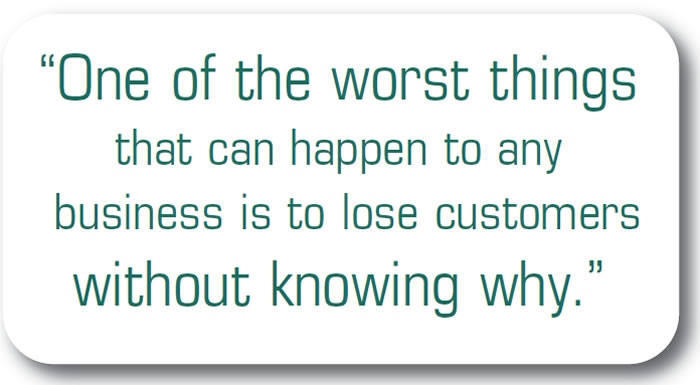
It’s Your Business
- Author: Terry Greenhut, Business Editor
- Subject Matter: Management
- Issue: Dissatisfied customers
One of the worst things that can happen to any business is to lose customers without knowing why. How do you fix a problem when you don’t know what it is? Often when customers stop using our services they are upset about something. It might be about price, quality or service, but these are all broad areas. What is it specifically? Since we all base our decision as to whether to go back to a certain establishment on our last experience with it, what went wrong? What happened that last time?
Every once in a while you will get some warning from an unhappy customer, such as, “You know, those last six transmissions you did for me all came back. If you can’t do better maybe I should find another shop that can!” or “I don’t understand why it only takes your shop two days to rebuild a transmission for me but if anything goes wrong and I have to bring it back my truck sits in your shop for two weeks.”

It’s not always easy to find out what customers like about our service, but it’s much harder to get them to discuss what they don’t like. Maybe it’s because a lot of us were raised by the adage, “If you don’t have anything nice to say, don’t say anything.” Others may not speak up when they are upset because they don’t handle confrontation well. Then there are those who think shortcomings in customer service are just a normal occurrence, but the vast majority just don’t care enough about our businesses to say anything. They’re busy enough handling their own affairs. If we don’t treat them well they just don’t come in anymore. That’s how they tell us they are upset.
That doesn’t do us any good because we’ve already lost the customer and didn’t learn how to keep it from happening again. When we ask people what they thought of our service, the ones who really liked us might make a comment but the ones who didn’t care much for us probably won’t say anything. They’ll just leave us to struggle on our own while they tell their friends, or worse, post on the Internet how unsatisfactory we were. Maybe that’s how they punish us for not taking good care of them. The worst of it is that we might lose them and any referrals they might have given us without ever knowing why.
To get the answers you need you often have to dig a little deeper. Instead of asking the customer whether everything went OK you’d be better off asking, “What didn’t you like?” Or, “Tell me one thing you would change or improve about your experience with our service.” They might be shocked that you would even ask a question like that. Odds are they’ve never been asked it before and maybe never will be again. I had an incident just this morning that brought this question to the forefront.
New York requires yearly state safety inspections and, in some counties, emissions inspections also. You get a sticker on your windshield that indicates the month and year it expires. If your vehicle is parked on the street or being driven on a public road and the authorities pull you over or happen to spot an expired sticker, you get a hefty fine and you still need to have the car inspected or risk another fine every time you take it out of the garage.
My wife’s two-year-old car was due for inspection, and since it had only 14,000 miles on it I wasn’t concerned about it failing. I just wanted to get the inspection and an oil change and be on my way. I decided to take the car to my cousin’s Chrysler, Jeep and Hyundai dealership because it’s where we get all our cars and because I trusted that it would be done quickly and correctly.
As a little sidelight, I trained all the service advisers at this dealership about three years ago. The one who handled me today, though, was not one of them. I’d never seen him before. Anyway, it took him all of about a minute to make smoke come out of my ears. When he asked what I needed done today I told him I wanted only a state inspection and an oil change.
His response was, “You know, you have almost 15,000 miles on your car and it’s due for the 15,000-mile services.” When I tried to explain that the car now gets driven only three miles a day back and forth to the commuter train station and that it has only one more year to go on the lease, he said: “If you don’t let me do this service the manufacturer will void your warranty. I’ll have to write it on the bill that you refused my recommendation and then if anything goes wrong you’ll be on your own.” My brain instantly went into “I want to punch his lights out” mode. Threatening me; is that any way to sell service?

I wonder how many times a day this service writer uses intimidation and threats to make a sale. I was absolutely livid that this “service salesman” would use such a threat on his customers, so I decided to turn it around and intimidate him a little. I said, “Before you write that on my bill I think you should know that my cousin owns this dealership and pays me a lot of money to teach his staff how to sell his customers products and services based on the benefits they can derive from them, not on how scared they will be not to have the services performed. Would you like me to make him aware of the tactics you’re using?”
“Wait a minute,” he said. “You don’t understand. I was just giving you a friendly reminder that these services need to be done.”
“It didn’t sound very friendly to me”, I said. “I think it’s time you learn some new tactics before you lose this dealership too many customers.”
When I came back to pick up the car a couple of hours later the service adviser at the next desk took care of me. He knew who I was and I think he overheard my earlier conversation with his coworker. When he asked how my experience was with my visit to the service department he smirked just enough to indicate that he knew. Although I didn’t tell him how I felt about it because the other adviser was within earshot, I will lay it all out for my cousin when we play golf together on Friday. This just can’t happen if you want a successful business, but if customers or other employees don’t tell the owner what’s really going on, it can’t be fixed.
A customer and very good friend of mine who owns a $3-million-a year shop in the Midwest is so into customer service that he gets personally involved when a sale is lost in order to either salvage it or create a future customer from the experience. He instructs all his service advisers that they must notify him directly if they are not 100% sure that the customer’s experience was as close to perfect as possible or if they lose a sale for whatever reason. His perception of any kind of a problem that might cause a customer not to come back or recommend a friend prompts him to make an immediate phone call to rectify whatever the issue might be. He knows that if these situations are not handled right away it will usually be too late. It may seem as though he is micro-managing his service advisers, but I don’t see it that way. He is protecting and building his business – something every shop owner should be doing continually.
Want to find out what customers really think and how that information can be used to fix existing problems? Ask, but be specific. General questions don’t usually yield specific answers. You need to know in detail if something went wrong, how bad it was, what needs to be done to fix it, how that can be implemented and what damage-control procedures must be taken to save any customers you might lose on account of the incident.
One of the most-difficult things a small-business owner has to cope with is losing customers and not knowing why. He can assume anything he wants to, but what is the truth? If you don’t know, how can you fix it? The best thing an owner can do is to stay involved with the day-to-day and moment-to-moment operation of the business. Even if they have managers who are supposed to be running and supervising the business, the owner’s job is to supervise the supervisors, to keep a hand in every phase of the business so they know immediately what’s wrong and what needs to be fixed. It’s a continuing struggle that never goes away.
The worst words an owner can say are, “Gee, things are really going great,” unless he or she follows it up with, “I must have missed something.” If you’re a shop owner, or ever plan to be one, you have to learn enough about and stay on top of every phase of your business if you want it to reward you.

Terry Greenhut, Business Editor, visit www.TerryGreenhut.com.













